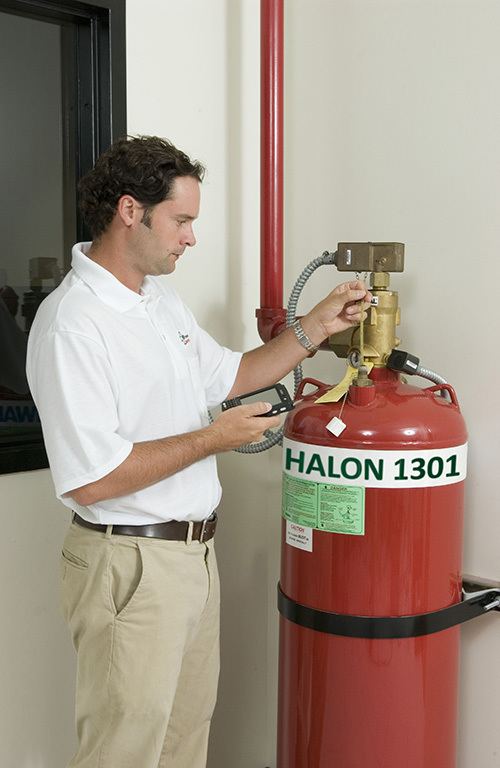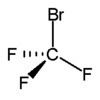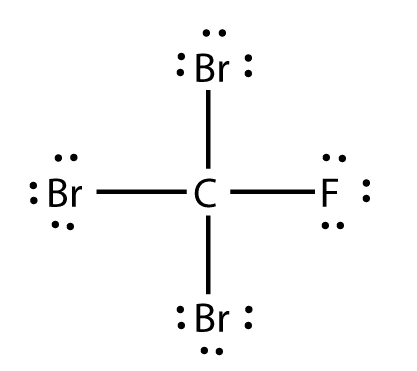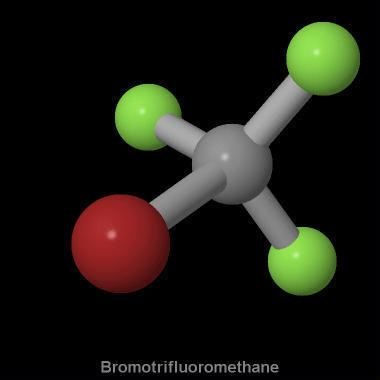Appearance Colorless gas Boiling point -57.75 °C | Density 1.54 g/cm³ | |
 | ||
Bromotrifluoromethane, commonly known as Halon 1301, R13B1, Halon 13B1 or BTM, is an organic halide with the chemical formula CBrF3. It is used for fire suppression and refrigeration. Human exposure to Halon 1301 can be toxic, affecting the central nervous system and other bodily functions. Additionally, it is known to contribute to the depletion of Earth's atmospheric ozone layer when released. As such Halon's use as a refrigerant has been virtually eliminated and alternatives are being used increasingly for fire suppression.
Contents

Uses

Halon 1301 was developed in a joint venture between the U.S. Army and DuPont in 1954, and introduced as an effective gaseous fire suppression fixed systems agent in the 1960s, and was used around valuable materials, such as aircraft, mainframe computers, and telecommunication switching centers, usually in total flooding systems. It was also widely used in the maritime industry to add a third level of protection should the main and emergency fire pumps become inoperable or ineffective. Halon 1301 was never widely used in portables outside military and spacecraft applications, due to its limited range, and invisible discharge. It does not produce the characteristic white cloud like CO2 and is difficult to direct when fighting large fires. Halon 1301 is ideal for armored vehicles and spacecraft, however, because it produces less toxic by-products than does halon 1211, which is critical for combat or space conditions where a compartment may not be able to be ventilated immediately. Halon 1301 is widely used by the U.S. Military and NASA in a 2-3/4 lb portable extinguisher with a sealed, disposable cylinder for quick recharging. Other agents such as CO2 and E-36 Cryotech wet chemical are largely replacing halon 1301, however, due to environmental concerns. Civilian models in 2-3/4, 3, and 4 lb sizes were also made.

It is considered good practice to avoid all unnecessary exposure to Halon 1301, and to limit exposures to concentrations of 7 percent and below to 15 minutes. Exposure to Halon 1301 in the 5 to 7 percent range produces little, if any, noticeable effect. At levels between 7 and 10 percent, mild central nervous system effects such as dizziness and tingling in the extremities have been reported. In practice, the operators of many Halon 1301 total flooding systems evacuate the space on impending agent discharge.

There is also a risk of the production of toxic and irritant pyrolysis products, mainly hydrogen bromide and hydrogen fluoride.
Due to lessons learned in the Vietnam War, the use of Halon 1301 began in the F-16 fighter aircraft to prevent vapors in the fuel tanks from becoming explosive. Upon entering areas with possible unfriendly fire, Halon 1301 is injected into the fuel tanks for one-time use. Due to environmental concerns, trifluoroiodomethane (CF3I) is being considered as an alternative.
Bromotrifluoromethane was also used as a filling of the bubble chamber in the neutrino detector Gargamelle.
Before the dangers of Halon 1301 as an ozone depleter were known, many industrial chillers used it as an efficient refrigerant gas.
Alternatives
Alternatives to Halon 1301 in fire extinguishing systems are being deployed. Many installations from which halon is removed can be protected with fire sprinklers, depending on the level of damage the equipment in the space will incur by exposure to water. In other cases, different total flooding agents can be used. The alternatives for normally occupied areas include (PFC-410 or CEA-410), C3F8 (PFC-218 or CEA-308), HCFC Blend A (NAF S-III), HFC-23 (FE 13), HFC-227ea (FM 200), IG-01 (argon), IG-55 (argonite), HFC-125, or HFC-134a. For normally unoccupied areas, the alternatives include carbon dioxide, powdered Aerosol C, CF3I, HCFC-22, HCFC-124, HFC-125, HFC-134a, gelled halocarbon/dry chemical suspension (PGA), blend of inert gas, high expansion foam systems and powdered aerosol (FS 0140), and IG-541 (Inergen). Perfluorocarbons, i.e., PFCs such as C3F8, have very long atmospheric lifetimes and very high global warming potentials. Hydrochlorofluorocarbons, i.e., HCFCs including HCFC containing NAF S-III, contain chlorine and are stratospheric ozone layer depleters, although less so than Halon 1301. Their selection for usage as Halon replacements should consider those factors, and is restricted in some countries.
